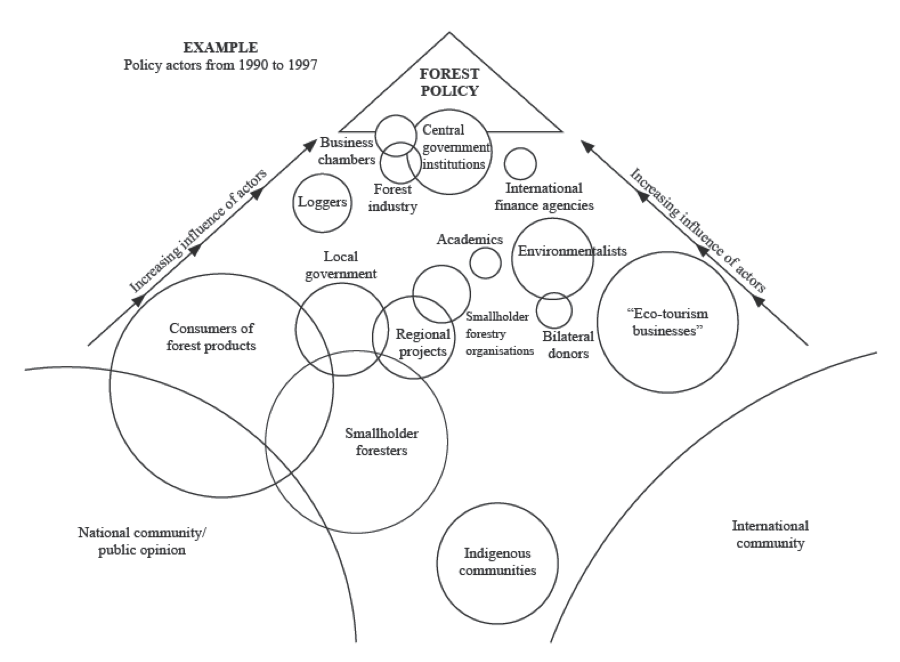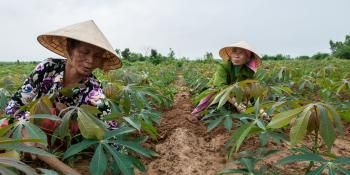Researchers map actors’ power and influence in adaptation policy

Power relations between actors in adaptation regimes can determine how adaptation is defined, who or what is considered “vulnerable”, and what adaptive measures are prioritized. A methodology for mapping power dynamics between actors in these systems is the subject of a new CCAFS Working Paper.
Development of climate change adaptation policy is a politically charged activity. It involves competing interests, fighting for scarce resources and requires decisions to be made on the basis of imperfect -- and often contested-- information. Ultimately, the direction that these policies take is strongly affected by the power dynamics between actors within the adaptation regime.
A new Working Paper by the CGIAR Research Program on Climate Change, Agriculture and Food Security (CCAFS) entitled “Multilevel Stakeholder Influence Mapping in Climate Change Adaptation Regimes” aims to shine light on this very topic by advancing a methodology for visually mapping power and influence dynamics in adaptation regimes.
Multi-level Stakeholder Influence Mapping (MSIM) has been developed by CCAFS Systemic Integrated Adaptation (SIA) program based at the University of Oxford. It is a simple visual tool to examine and display the relative influence that different actors have over a focal issue.
The mapping tool builds on the work of International Institute for Environment and Development’s (IIED) “Power Tools” Stakeholder Influence Mapping tool.
The IIED tool has been utilized by CCAFS in trials in Uganda in 2010 as a means of delineating strategies for influencing climate change adaptation policy.
MSIM diagrams, or ‘maps’, are constructed in a participatory process with stakeholders. Circles represent different actor groups in the adaptation regime (or any regime in question), and a pyramid represents the adaptation policy process.
The respondent, or ‘mapper’, begins the activity by first choosing potential actors, marking those that he/she feels are ‘highly relevant’ to the policy process. One-by-one, these ‘highly relevant’ actors are placed on the pyramid. The actors deemed most influential are placed near the top of the pyramid and those deemed less influential near the bottom (see example map from a ‘forest policy’ study below).
Relationships, like the degree of cooperation between actor groups, can be indicated by the closeness or overlap of the circles, and the relative population of the organization is represented by the size of the circle. While each actor is placed on the map, the respondent identifies the reasons for the placement, citing key moments and mechanisms that yield power/influence, and other information regarding the perceived legitimacy and authority of the actor.

Above: Multi-level Stakeholder Influence Mapping (MSIM) diagram
This mapping process is repeated multiple times with different stakeholders (individually). The maps can be combined to produce a composite diagram visualizing the collective power and influence perspectives from across the adaptation regime.
Combined maps can also be produced for actors operating at similar operational ‘levels’ (i.e. all maps drawn by only district level respondents). In this way, through individual and combined visual maps, the MSIM process identifies barriers to policy implementation, highlights disparities in decision-making, and identifies key, influential bridging-agents between actor levels in adaptation regimes.
MSIM is a simple, cost effective, and timely way to map-- in a non-intimidating manner -- the power dynamics that project managers, academics, and development practitioners all deal with on a regular basis, whether they work in climate change adaptation or any other complex problem area. Understanding these power dynamics and taking steps to reduce the negative effects i.e. exclusion of certain stakeholder groups from decision-making, non-equitable implementation, can to improve project success rates and magnify impacts.
This Working Paper reports on the pilot of the MSIM methodology conducted with 14 respondents from Nepal’s agricultural adaptation regime. An analysis and discussion of the maps then yields three key power/influence trends that could be potentially targeted for intervention. This includes village-level representation in decision-making in the country’s adaptation regime, the role of agricultural indicators in Nepal’s vulnerability assessment, and the engagement of smallholder producers and international consultants in the development of the country’s National Adaptation Programme of Action (NAPA).
Read more: New paper outlines Nepal's efforts to combat climate change effects
Questions about equity, justice and fairness remain at the core of much of the political debate over the design and implementation of large-scale environmental and development institutions. The stake-holder mapping tool helps to bring these issues to the fore in climate change adaptation regimes.
As funds continue to flow towards climate change adaptation, and the process of policy integration progresses, a look at power and influence in adaptation regimes is needed, in order to ensure that adaptation measures are not embedded within existing inequality-producing structures and that vulnerable populations receive the support necessary to successfully adapt to changing climates.
Download the Working Paper: Sova CA, Helfgott A, Chaudhury AS. 2013. Multilevel stakeholder influence mapping in climate change adaptation regimes. Working Paper No. 46. CGIAR Research Program on Climate Change, Agriculture and Food Security (CCAFS). Copenhagen, Denmark.
Chase Sova is a visiting researcher at the International Center for Tropical Agriculture (CIAT), and co-author of the Working Paper "Multilevel stakeholder influence mapping in climate change adaptation regimes". He is also part of the Systemic Integrated Adaptation (SIA) program.


